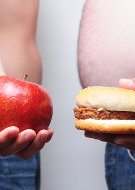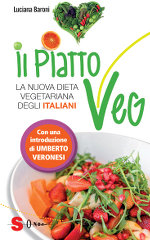
Energy (Calories)
The "calories" that we always measure in foods (to avoid consuming too much!) are nothing more than a measure of the energy obtained from food and which is then used by the body for its various functions. To be precise, a kilocalorie (or kcal) is the amount of heat required to raise to 1 liter of water by 1° centigrade.

The energy that our organism requires is used to support vital functions (breathing, heart activity, body heat production, i.e., the basal metabolism) and additional physical activity, and will be that much greater, the greater is our physical activity. Energy comes from food, specifically from macronutrients: proteins, carbohydrates, fats. Even alcohol is a source of calories, while water and food do not contain energy.
The caloric density of a food comes from these 6 substances: it is high when small volumes contain many calories. Because the feeling of satiety depends on the volume of food eaten, foods that have a low caloric density are those that with large volumes contain fewer calories, so we can be satisfied without consuming too much energy.
Here are the amount of calories contained in 1 gram of substance:
Lipids: 9; alcohol: 7; proteins and carbohydrates: 4; fiber: 0-2; water: 0.
High caloric density foods are those rich in fats, simple sugars, or alcohol and poor in water and fiber. These foods (beside alcohol) are those of animal origin and industrial foods. Care should be taken because a large part of the total number of calories is consumed "between meals": snacks and sugary or alcoholic beverages.
The calorie needs of the organism is in keeping with its needs for nutrients, meaning that if the foods we consume contain the correct amount of calories, they also contain the nutrients we need. This applies to natural foods rich in nutrients; Instead the foods that contain lots of calories but few or almost no nutrients, supply only calories ("empty calories") that may be in excess.
The allowance of empty calories that we consume every day in order not to exceed the appropriate caloric quantity is expressed as "discretionary calories" and is of rather low quantity. If more is consumed, there is the risk of overweight-obesity. If, conversely, we consume the right amount of calories but they come from foods with high calories and low nutrients, then it means we are not getting the necessary nutrients and are at risk of malnutrition.
In addition, a healthy body weight depends on the balance between intake of calories in the diet and those used: body weight can be kept in check by decreasing the amount of caloric intake or increasing energy consumed, there are no other ways and so it is important, to know one’s own energy requirement.
To limit calorie intake without restricting the volume of food intake and therefore without always feeling hunger you need to choose low calorie density foods, namely plant groups of 5 foods: grains, legumes, vegetables, fresh fruit and small amounts of nuts and oilseeds. Such foods should be consumed as much as possible "as harvested" in such a way that they maintain their fiber and water content, and salt and seasonings are added in limited quantities .
To increase your caloric expenditure, i.e., energy consumption, it is necessary to increase daily physical activity.
Calorie requirements calculation
This table shows estimates of the amount of calories needed to maintain energy balance, according to age group, gender, and three different levels of physical activity.
Sedentary indicates a lifestyle that includes only the light physical activity of everyday life.
Moderately active indicates a lifestyle that includes physical activity equivalent to a walk of 2.5-5 km at a speed of 5-6.5 km / hour, in addition to the light physical activity of everyday life.
Active indicates a lifestyle that includes physical activity equivalent to a walk of more than 5 km at a speed of 5-6.5 km / hour, in addition to the light physical activity of everyday life.
Requirements for women in calories, aged 18 years and over:
| Age |
Sedentary lifestyle |
Moderately active lifestyle |
Active lifestyle |
|---|---|---|---|
| 18 | 1800 | 2000 | 2400 |
| 19-30 | 1800-2000 | 2000-2200 | 2400 |
| 31-50 | 1800 | 2000 | 2200 |
| 51 and above | 1600 | 1800 | 2000-2200 |
Requirements for men in calories, aged 18 years and older:
| Age |
Sedentary lifestyle |
Moderately active lifestyle |
Active lifestyle |
|---|---|---|---|
| 18 | 2000-2400 | 2400-2800 | 2800-3200 |
| 19-30 | 2400-2600 | 2600-2800 | 3000 |
| 31-50 | 2200-2400 | 2400-2600 | 2800-3000 |
| 51 and above | 2000-2200 | 2200-2400 | 2400-2800 |
Discretionary calories
As already mentioned, the energy that comes from food can be divided into:
- essential calories: which are those required to provide the nutrients required by the body, thus avoiding deficiencies; they should therefore be provided by foods that contain not only energy, but nutrients as well. For example, large amounts of sweets are consumed, there will be a lot of calories but few nutrients and so the diet will cause a principle nutrient deficiency.
- Discretionary calories: are those that we can consume in addition to the essential calories, which can also come from foods that do not contain nutrients, i.e., the so-called "empty calories".
The amount of discretionary calories available is calculated assuming that essential calories come from foods nutrient dense, that is to say, foods that contain little fat and simple sugars. If, instead, for the essential calories foods high energy density used, that is with few nutrients with regards to the calories, then the quantity of discretionary calories will be very low, if anything.
Furthermore, it is necessary to consider that the right choice of food also affects our health: choosing foods that contain nutrients that do not protect our health or that may even be potentially harmful (such as those contained in animal food and junk-food) can have important repercussions.
The same discretionary calories should preferably be obtained from nutritious foods, that provide vitamins, fiber, phytochemicals, since consuming them from foods that contain empty calories can lead to an increased risk of disease (even simply of tooth decay, but also with risk for vascular diseases and tumors).
Just the same, given that today's society encourages the eating of junk-food, namely foods loaded with fat, salt and empty calories, you can't always avoid them altogether.
In the VegPlate figure, discretionary calories are represented by the saucer/glass outside of the plate at the top right. If it is desired to avoid to consume them from empty calories, simply increase the quantity of foods belonging to the 6 major groups of VegPlate to reach the total amount of calories.
Ultimately, it's good, in the daily diet:
- limit foods and drinks that are high in simple sugars, fats and alcohol, which make supply empty calories.
- Choose foods with a beneficial nutrient/calorie ratio, that is to say: either with a high nutrient density or with a not high nutrient density, but with a low calorie density to compensate (such as vegetables). These foods have a discrete volume and provide a feeling of satiety before consuming too many calories.
- Eat only foods of the 6 food groups of VegPlate, to obtain your calorie needs (option 1).
- Alternatively, small amounts can be consumed of foods that supply only empty calories, which contain fat and sugar, knowing full well that this penalizes the intake of protective substances and can encourage the intake of harmful substances (option 2).
Choosing foods rich in vitamin E, potassium, calcium and dietary fiber, i.e, plant foods, increases the quantity of discretionary calories.
Discretionary calorie table - option 1
The table shows the foods belonging to the VegPlate and thus belonging to a healthy and correct diet.
Source: Luciana Baroni 2015, Il PiattoVeg, Sonda edizioni.
| Food | Quantity | Kcal |
|---|---|---|
| Avocado | 100 g | 231 |
| Dried figs | 5 (80 g) | 205 |
| Tofu in sauce | 90 g | 193 |
| Pistachios | 30 g | 183 |
|
Oilseeds (almonds,
hazelnuts, walnuts, etc.) |
30 g | 177 |
| Dried apples | 10 rings (64 g) | 155 |
| Dried apricots | 50 g | 137 |
| Breadsticks | 30 g | 129 |
| Melba toast | 30 g | 122 |
| Crackers | 30 g | 120 |
| Rice cakes | 30 g | 114 |
| Oatmeal in flakes | 30 g | 112 |
| Fruit juice | 1 tetrapack (200 ml) | 112 |
| Plums, dried | 50 g | 110 |
| Muesli | 30 g | 109 |
| Cornflakes | 30 g | 108 |
| Bananas | 150 g | 98 |
| Tahin/peanut butter | 15 g | 92-95 |
| Sesame seeds | 15 g | 86 |
| Bread, type 0 flour | 30 g | 83 |
| Cream of hazelnuts and cocoa | 15 g | 81 |
| Fruit rice-yogurt | 1 small jar (125 g) | 79 |
| Whole-grain bread | 30 g | 73 |
| Olives | 30 g | 71 |
| Rice beverage | 125 ml | 63 |
| Soy yogurt white | 1 small jar (125 ml) | 63 |
| Apple Juice | 125 ml | 58 |
| Almond milk | 125 ml | 56 |
| Oat milk | 125 ml | 56 |
| Fresh fruit | 150 g | 56 |
| Orange juice, fresh squeezed | 125 ml | 55 |
| Almond butter | 10 g | 46 |
| Extra-virgin olive oil | 5 ml | 45 |
| Carob flour | 15 g | 29 |
Discretionary calorie table - option 2
The tables show the simple sugar and fat-based foods, which supply only empty calories.
Source: Luciana Baroni 2015, Il PiattoVeg, Sonda edizioni.
| Food | Quantity | Kcal |
|---|---|---|
| Pound cake | 100 g | 367 |
| Chocolate-covered ice cream | 100 g | 316 |
| Shortbread cookies | 5 (60 g) | 255 |
| Bagged potato chips | 50 g | 254 |
| Coconut milk | 125 ml | 246 |
| Nougat | 50 g | 240 |
|
Coconut bar covered
with dark chocolate |
50 g | 236 |
| Sponge cake | 50 g | 230 |
| Jam tart | 60 g | 203 |
| Savoiardi biscuits | 50 g | 195 |
| French fried potatoes | 100 g | 188 |
| Croissant | 1 da 50 g | 179 |
| Cookies | 5 (35 g) | 145 |
| Coca cola | 1 can (330 ml) | 129 |
| Soy dessert | 1 small jar (125 g) | 129 |
| Carbonated beverage | 1 can (330 ml) | 125 |
| Stuffed pastry | 30 g | 124 |
| Beer, lager | 1 medium or can (330 ml) | 112 |
| Chocolate, dark | 20 g | 103 |
| Fruit in syrup | 150 g | 90 |
| White or red wine | 125 ml | 88 |
| Wine, sparkling | 1 flute (80 ml) | 70 |
| Coconut flour | 10 g | 70 |
| Marmalade | 25 g | 55 |
| Cocoa, unsweetened | 15 g | 53 |
| Vegetable mayonnaise | 5 g | 25 |
| Sugar | 5 g | 20 |
VegPlate - the books

